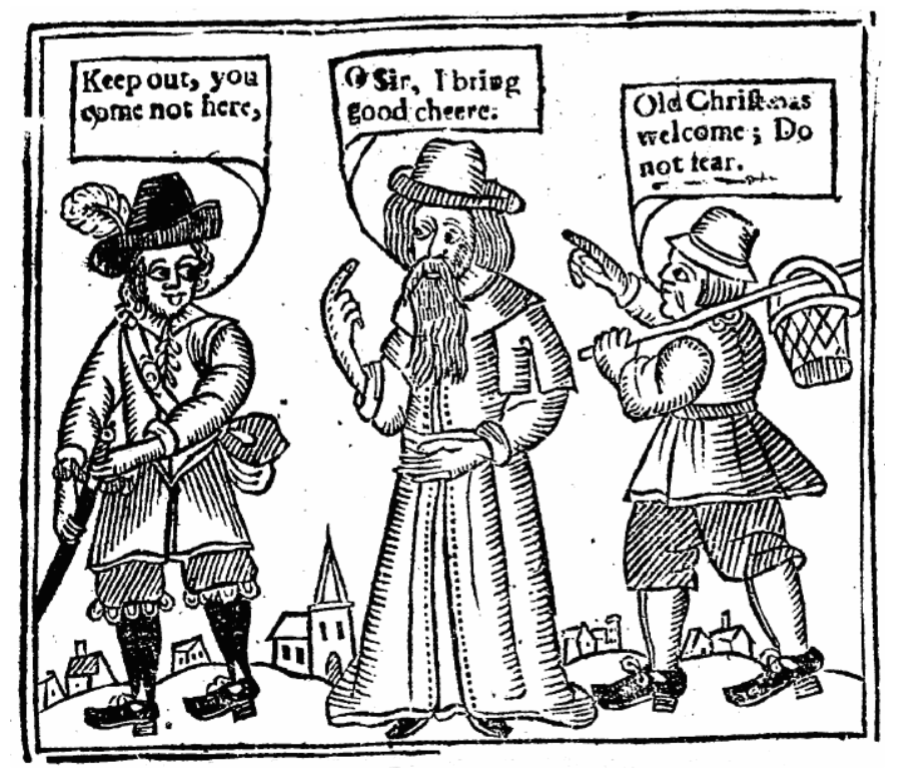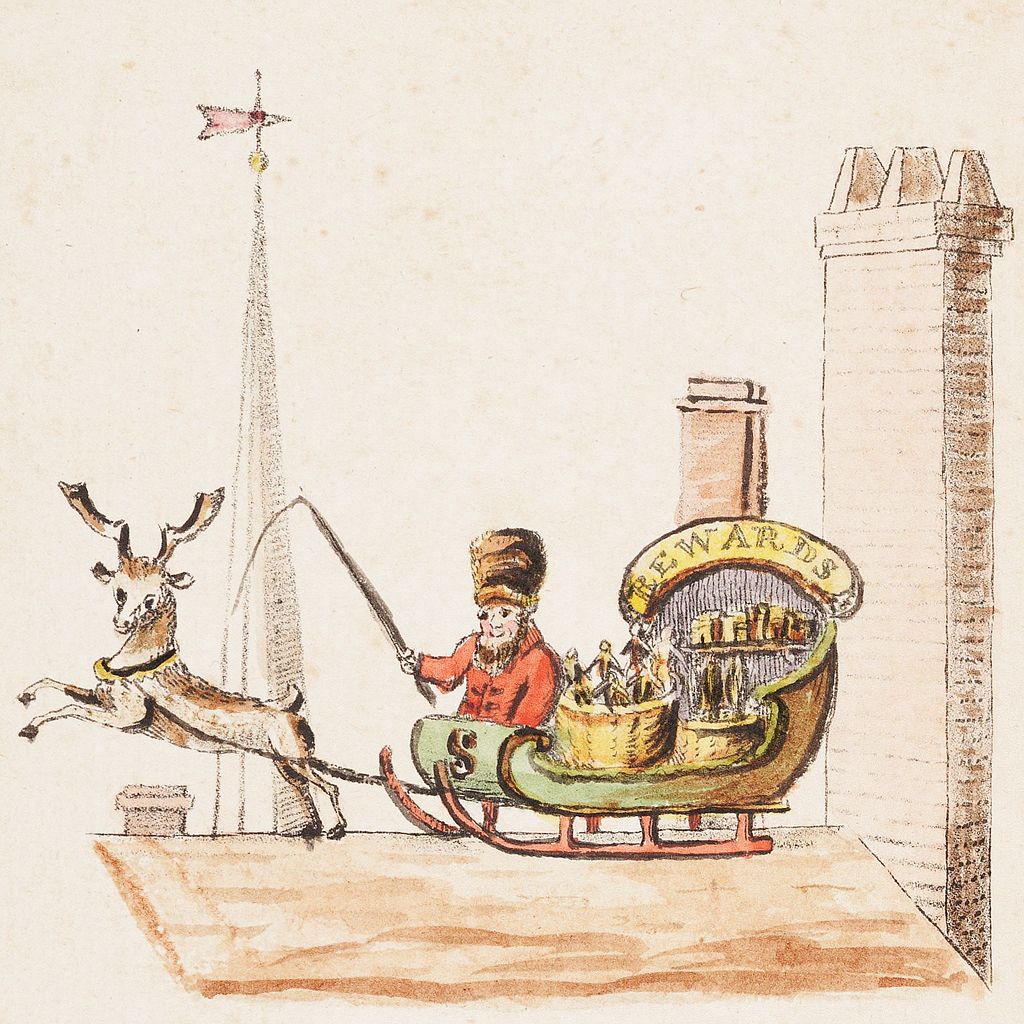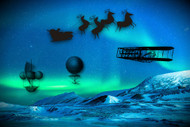Where Was Santa When the World Was Learning How to Fly?
By on Dec 21st 2016
The evolution of Santa alongside the evolution of early flight
'Twas the week before Christmas and some of us were wondering-hey, if Santa could fly for all this time, where was he when the rest of us were learning to fly?
A man by any other name would still be jolly
Santa Claus. Saint Nicholas. Saint Nick. Kris Kringle. Father Christmas- whatever you call him, the legend of Santa is old. Really old . . . as in 4th century old.

St. Nick
Our modern vision of good old Santa Claus comes out of the historical St. Nicholas (Nikolaos of Myra), a 4th century Christian saint and Bishop who became the subject of legends with his piety and kindness.
He became known as the protector of children and sailors, as he would travel around in his red robes and give gifts to the poor. Legend has it that he dropped some gold coins down a family's chimney, and they landed in a girl's stocking.
In Europe he has been portrayed as a bearded Bishop in canonical robes.
Unfortunately, this St. Nick couldn't fly.

Though the origin of mankind's first desire to fly is unknown, the primitive beginnings of early attempts of flight go back at least as far as the Greek legend of Daedalus and Icarus. Eventually individuals tried to construct real flying devices and tested them by jumping off a tower, hill, or cliff. These -tower jumping- techniques weren't successful.
Kites, invented in China possibly as early as the 5th century, can be considered one of the first forms of man-made aircraft. Kites didn't reach the West until 1634. Evidence of man-carrying kites exists from the 6th century in China.

Father Christmas

People have been celebrating Christmastide since at least the High Middle Ages (c 1100-1300), although pagan celebrations of winter occurred in ancient Britain. This general pagan figure dressed in a long green hooded cloak and a wreath of holly, ivy or mistletoe. Merry-making, signing, and drinking were the first associations with the English -personification- of Christmas.
In January 1443, a man named John Gladman was crowned and disguised as the -King of Christmas.- He rode behind a pageant atop a horse decorated with tinfoil. Other personifications of Christmas continued with -Lord of Misrule- characters like -Captain Christmas,- -Prince Christmas,- or -The Christmas Lord.-
In the early 17th century, writers used personification to defend Christmas from Puritans. Father Christmas, depicted as a large man in green or scarlet robes lined with fur, was essentially banned, and wasn't revived as the spirit of Christmas until the Victorian era. This pagan figure didn't fly, either.

By the Renaissance, investigators began to discover some of the basics of scientific aircraft design; these designs were either man-powered or used a metal spring. In 1250, Roger Bacon predicted future designs for filled balloons and a man-powered ornithopter.
In the 15th century, Leonardo da Vinci designed flying machines and mechanisms, including ornithopters, rotorcraft, parachutes, and a hang glider design based on the flight of birds.
Modern lighter-than-air flight began in the 17th century when Galileo demonstrated that air has weight. Francesco Lana de Terzi, the -father of Aeronautics,- first sketched the concept for a hypothetical vacuum airship.
In 1647, Italian inventor Tito Livio Burattini built a model aircraft with 4 fixed-glider wings, which was said to have successfully lifted a cat. His -Drago Volant- is considered to be the most elaborate and sophisticated aircraft to be built before the 19th Century.
The first documented European balloon flight occurred August 8, 1709 in Lisbon. Brazilian priest Bartolomeu de Gusmão made a small hot-air balloon of paper with a fire burning beneath it.
1783 was an important year in ballooning; between June 4 and December 1, five separate French balloonists achieved a number of aviation feats, including lifting animals in a hot air balloon; the flight on an unmanned hydrogen balloon; the first manned flight; and the first flight with 3 human passengers.

Santa Claus
Eventually, St Nicholas and the English Father Christmas joined forces to create the American "Santa Claus."

Santa Claus (first used in 1773) developed as a derivation of the Dutch St Nicholas, -Sinterklaas-. The now-Americanized Santa ditched his bishop apparel and was initially pictured as a thick-bellied Dutch sailor with a pipe and green winter coat in Washington Irving's History of New York (1809).
In 1821, an anonymous poem was published entitled -Old Santeclaus with Much Delight.- This poem describes -Santeclaus- as bringer of presents to children (via a reindeer-pulled sleigh).
More modern ideas of Santa became canon after the poem -A Visit From St. Nicholas- was published anonymously December 23, 1823. Better known today as -The Night Before Christmas,- it was later attributed to Clement Clarke Moore. Within the poem, Santa is described as a "chubby and plump, a right jolly old elf" with "a little round belly", that "shook when he laughed like a bowlful of jelly". He rides in a -miniature sleigh- with -tiny reindeer".
19th century Santa became a large, heavyset man. This modern perception of Santa was highlighted (and likely defined) by Thomas Nast's 1863 cartoon which appeared in Harper's Weekly. Nast might have also created the notion that Santa lives at the North Pole.
But more importantly-come the 19th Century, Santa has reindeer and can fly!
"He sprang to his sleigh, to his team gave a whistle,
And away they all flew like the down of a thistle.
But I heard him exclaim, ere he drove out of sight,
HAPPY CHRISTMAS TO ALL, AND TO ALL A GOOD-NIGHT!"

The first published paper on aviation was Emanuel Swedenborg's "Sketch of a Machine for Flying in the Air" in 1716. Though he knew it could not fly, he believed it was a start and was confident the problems of a power source could be overcome.
Attempts at man-powered flight continued, and fatal tower jumping was replaced by balloon jumping.
Sir George Cayley became the -father of the aeroplane" in 1846. He designed the first heavier-than-air aircraft. In 1866, the Aeronautical Society of Great Britain was founded.
The 19th century also saw the continued development of dirigibles (now called airships). The first sustained powered, controlled flight in history occurred September 24, 1852 when Henri Giffard flew 15 miles in France with the Giffard dirigible. Count Ferdinand von Zeppelin first formulated the notion of a rigid airship in 1874. He would found the Zeppelin firm in the 20th century.
In the last decade of the 19th century, the modern airplane was really starting to be refined-and defined.

20th Century Claus
Santa continued to become a popular figure during the 1900s, although his mythos was not set in stone. In L. Frank Baum's 1902 children's book, The Life and Adventures of Santa Claus, Santa was immortal, lived in Hohaho, and had 10 reindeer who couldn't fly, but could leap in enormous bounds.
Coca-Cola advertising in the 30s further popularized Santa, although they weren't the first beverage company to use him. Santa's image as a benevolent person was reinforced with his association to philanthropic organizations, such as the Salvation Army.
In some images from this time, Santa is depicted as personally making his toys.
By the end of the 20th century, the image of Santa and his reindeer had solidified themselves in the Western World.

Building upon a series of kite and glider designs from 1900 to 1902, Wilbur and Orville Wright managed to build a powered-design glider. After several years and a few poor-performing gliders, the Wright Brothers managed to design and build the Wright Flyer, the first successful heavier-than-air powered aircraft. The brothers flew it 4 times on December 17, 1903.
The decade between 1903 and 1914 marks the -Pioneer era- of aviation, as this time saw the development of practical airplanes and airships, as well as balloons and kites, for private, sport, and military use.
Today, all kinds of aircraft can fly. Just like Santa.

The moral of the story? Man hasn't always known how to fly--but then again, neither has Santa.
For more information on early flying machines, check out post on Prolific Early Flying Machine Inventors here.

Sources:
http://www.history.com/topics/christmas/santa-clau...
https://en.wikipedia.org/wiki/Santa_Claus
http://www.timetravel-britain.com/articles/christm...
https://en.wikipedia.org/wiki/History_of_aviation
https://en.wikipedia.org/wiki/Early_flying_machine...







